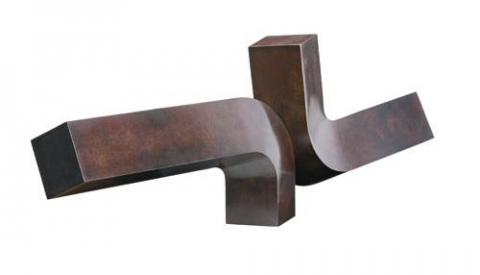NIGHT AND DAY, 1979-80
Clement Meadmore
bronze
34.0 x 91.0 x 14.0 cm
signed, dated and numbered at base: Meadmore 1980 2/6
Andre Emmerich Gallery, New York
Private collection, New York
Private collection, Melbourne
Gibson, E., The Sculpture of Clement Meadmore, Hudson Hills Press, New York, 1994, p.120, colour illustration of the larger version installed at Chelsea Harbour, London
In Australia during the late fifties into the sixties there emerged a number of sculptors of quality who raised the art in this country to a new level of achievement and appreciation. Coming from a variety of countries- Lithuania, Austria, England, Hungary, Germany, as well as the native-born- they were as stylistically different as their backgrounds. A group in Melbourne exhibited together under the name Centre 5, established in 1961, the same year as the Mildura prize for sculpture. In 1964, under the curatorship of Gordon Thompson, then Deputy Director of the National Gallery of Victoria, a national survey exhibition, Recent Australian Sculpture, went on tour to the State capitals, Canberra and Newcastle. One of the leading figures in this show was the Melbourne-born Clement Meadmore. The sense of the monolithic was already present in his exhibited work, Duolith III (National Gallery of Victoria), of welded sheet steel in the expressionist style then in vogue.
Moving to New York in 1963, his extrovert sculpture took on something of the exhilaration and latent power of the megatropolis, populating some of its famous public places and institutions. A 1978 work is titled Six-footmodel for six-hundred-foot skyscraper sculpture. Embracing international fame, his works are now found from London to Tokyo, throughout Australia, and prestigious collections the like of New York's Metropolitan Museum of Art and the Art Institute of Chicago. A master of Minimalist sculpture, his works celebrate the grandeur of complexity translated through the power of simplicity. On whatever scale, his sculptures are imbued with a feeling of monumentality, found equally in the gigantic Awakening, 1968 (Australian Mutual Provident Society, Melbourne) or in the more human size of Night and Day. If the Hellenistic sculptor of Laocoön was the master of the twist of ancient times, Meadmore won the accolade for the curve in our own. In Night and Day the balanced harmony of movement in opposition unites at the juncture of that twist, one half supported by the ground on which it stands, the other suspended, weightless, magically impossible. The fluidity and balance echo that of a prima ballerina, of elegance and finesse, giving, through its line and mass, a special presence to the environment of its placement.
DAVID THOMAS
